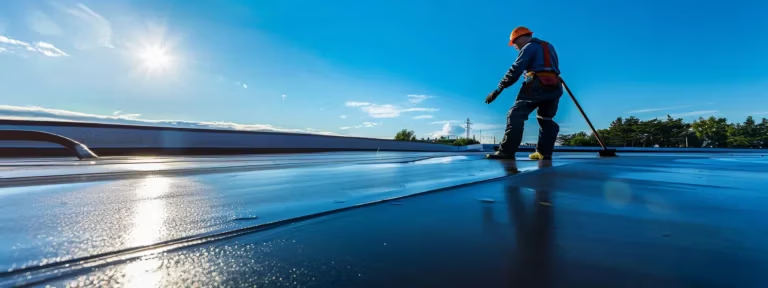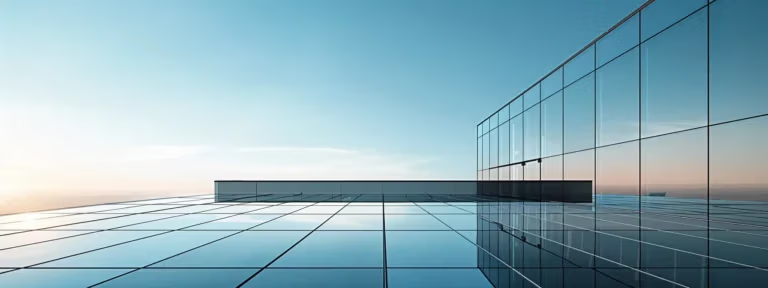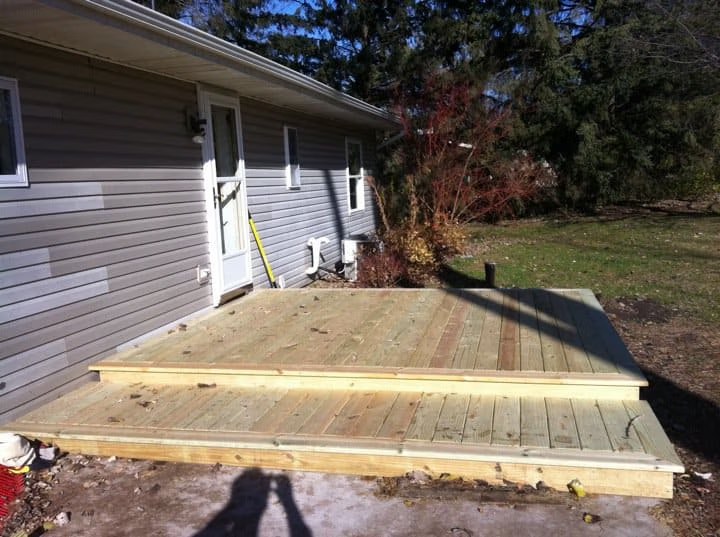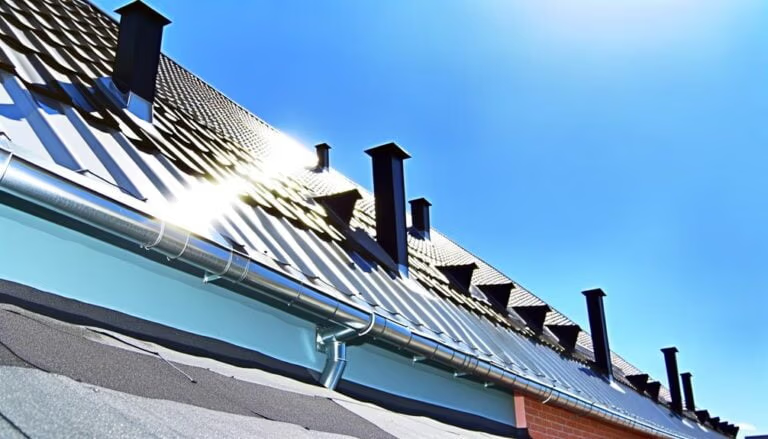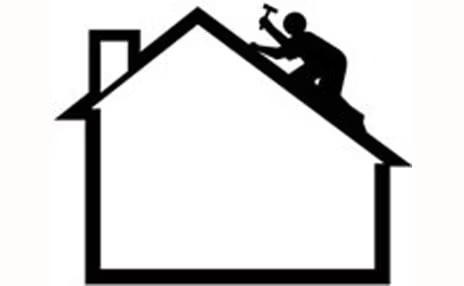Frequently Asked Questions
Can I build a roof over a deck with a hot tub?
Yes, you can build a roof over a deck with a hot tub. The roof will provide shade and protection from the elements, enhancing the enjoyment of the hot tub. However, ensure proper ventilation and consider local building codes before construction.
Can I add skylights to a roof over a deck?
Yes, you can add skylights to a roof over a deck. Proper ventilation, structural support, and waterproofing are crucial considerations when installing skylights on a deck roof.
What is the best type of roof for an existing deck?
A metal roof or asphalt shingles are common and durable options for an existing deck.
The choice depends on factors like budget, aesthetic preferences, and local weather conditions.
Consult a professional to determine the most suitable roofing material for your specific deck.
What are the benefits of adding a roof to my deck?
Provides shade and protection from the elements
Extends the usable outdoor living space
Enhances the aesthetic appeal of the deck
Increases the resale value of your home
Can I use solar panels on a roof over a deck?
Yes, solar panels can be installed on a roof over a deck, but considerations should be made for the roof's structural integrity, shading, and local building codes.
Do I need permits to build a roof over my deck?
The need for permits to build a roof over a deck depends on local building codes and regulations. Consulting with your local permitting authority is recommended to ensure compliance and obtain any necessary approvals before starting construction.
What are the local building codes for roofs over decks?
Minimum roof pitch typically 3:12 or steeper
Roof must extend at least 6 inches beyond the deck edge
Roof structure must be properly anchored to the deck frame
Roofing materials must meet local fire resistance requirements
Do I need to replace my deck before adding a roof?
Whether you need to replace your deck before adding a roof depends on the condition of the deck. If the deck is structurally sound, you may be able to add the roof without replacing the deck. However, if the deck is in poor condition, it's recommended to replace it before installing the roof.
What type of roof is best for an existing deck?
A flat roof is a practical choice for an existing deck as it is easy to install and provides shade.
A pitched roof can add visual interest and allow for better water drainage, but requires more complex installation.
Depending on climate and personal preference, a combination of flat and pitched roof sections may also work well.
Can I add a roof to a deck with a steep pitch?
Yes, you can add a roof to a deck with a steep pitch, but it requires careful planning and consideration of factors like structural support, ventilation, and water drainage. Consulting a professional is recommended to ensure the roof is installed safely and meets local building codes.
Can I use a prefabricated roof system for my deck?
Yes, prefabricated roof systems can be used for decks. These systems provide a convenient, pre-engineered solution that can be easily installed, saving time and effort on construction. They come in various styles and materials to match the deck design.
Do I need to upgrade my decks footings for a roof?
Upgrading deck footings for a roof depends on factors such as the roof design, weight, and local building codes. Consulting a licensed contractor is recommended to evaluate your specific requirements and ensure safety.
What is the purpose of a roof over a deck?
The primary purpose of a roof over a deck is to provide shade, shelter, and protection from the elements, such as sun, rain, and snow, allowing for more comfortable and extended use of the outdoor space.
Can I add a roof to my existing deck myself?
Yes, you can add a roof to your existing deck yourself, but it requires careful planning, building permits, and adhering to local building codes. Consider hiring a professional contractor to ensure the project is done safely and up to code.
Do I need a permit to add a roof to my deck?
Whether you need a permit to add a roof to your deck depends on local building codes. Check with your local building department to determine the specific requirements in your area, as permit needs can vary.
What are the benefits of building a roof over an existing deck?
Extends usable outdoor living space year-round
Provides protection from weather elements like sun, rain, and snow
Enhances property value and curb appeal
Offers a comfortable and shaded area for entertaining and relaxing
How much does it cost to build a roof over a deck?
The cost to build a roof over a deck can vary widely, ranging from $5,000 to $20,000 or more, depending on factors such as roof size, materials, labor, and local permit requirements.
What is the process of building a roof over a deck?
The process of building a roof over a deck typically involves:
Determining the deck's structure and size to design an appropriate roof.
Building a frame to support the roof and securely attach it to the deck.
Installing the roofing material, such as shingles, metal, or a flat roof system.
Ensuring proper ventilation, drainage, and weatherproofing for the new roof.
Can I add a roof to an old deck?
Yes, it is possible to add a roof to an existing deck. Important factors to consider include structural integrity, building codes, and aesthetics. A professional inspection and permitting may be required.
Can I add a roof to a deck with multiple levels?
Yes, adding a roof to a deck with multiple levels is possible. Key considerations include structural support, weather protection, and aesthetics to ensure the roof integrates seamlessly with the existing deck design.
What are the structural requirements for adding a roof to a deck?
Ensure the deck structure can support the additional weight of the roof.
Install proper footings, beams, and posts to provide a secure foundation for the roof.
Choose roofing materials suitable for the climate and design that meet local building codes.
Incorporate proper ventilation, drainage, and weatherproofing to protect the deck and roof structure.
Can I add a roof to a small deck or patio?
Yes, you can add a roof to a small deck or patio. Roofing options include awnings, pergolas, or permanent structures like a porch cover or gazebo. The choice depends on your budget, style preferences, and local building codes.
What are the maintenance requirements for a roof over a deck?
Inspect roof regularly for damage or leaks
Clean gutters and downspouts to prevent water buildup
Trim nearby trees and vegetation to prevent debris accumulation
Reseal roof seams and flashing as needed
Replace worn or damaged roofing materials periodically
What is the best roofing material for a deck?
Asphalt shingles, metal, or composite decking materials are commonly used for deck roofing due to their durability, weather resistance, and aesthetic appeal. The choice depends on budget, climate, and desired look.
Can I use my existing deck as the roofs foundation?
Using an existing deck as a roof foundation is generally not recommended, as decks are not designed to support the additional weight and load requirements of a roof. It is advisable to consult a professional to determine if the existing deck structure can be modified or if a new foundation needs to be installed.
How does a roof over a deck affect my homes value?
Adding a roof over a deck can increase a home's value by providing additional living space, improving energy efficiency, and enhancing the overall aesthetic appeal. The extent of the value increase depends on the quality of the construction and the desirability of the feature within the local real estate market.
Can I add a roof to a deck in bad condition?
It is generally not recommended to add a roof to a deck in poor condition. Doing so may exacerbate structural issues and create safety concerns. The deck should be properly repaired or replaced before considering a roof addition.
How do I attach the roof to the existing deck?
Secure pressure-treated wooden beams or joists to the existing deck structure.
Attach roof rafters or trusses to the beams, ensuring proper spacing and support.
Install roof sheathing, then apply roofing material of your choice, such as shingles or metal.
Seal any gaps or seams to create a weathertight connection between the roof and deck.
What are the different types of roofs for decks?
Flat roof
Pitched roof
Gable roof
Shed roof
Hip roof
How long does it take to build a roof over a deck?
The duration to build a roof over a deck can vary depending on several factors, such as the size of the deck, complexity of the roof design, and the experience of the construction team. On average, it can take 1-2 weeks to complete a standard deck roofing project.
Can I DIY a roof over my deck?
Yes, you can DIY a roof over your deck. Consider factors like deck size, local building codes, and desired roofing material. Proper planning, safety precautions, and seeking permits may be required for a successful DIY project.
How much does it cost to add a roof to a deck?
The cost to add a roof to a deck can vary widely, ranging from $3,000 to $15,000 or more, depending on factors such as the size of the deck, the type of roof, and the complexity of the installation.
How do I design a roof over a deck?
Consider the deck's dimensions and local building codes to determine the appropriate roof size and structure.
Choose a roof style (e.g., gable, hip, or flat) that complements the home's architecture.
Consult a professional to ensure proper structural support, ventilation, and drainage for the roof.
Select weather-resistant materials (e.g., asphalt shingles, metal, or tile) that match the home's aesthetic.
Obtain necessary permits and follow local building regulations throughout the design and construction process.
Can I build a roof over a second-story deck?
Yes, you can build a roof over a second-story deck. The structure must be engineered to support the additional weight and designed to blend with the home's architecture.
How do I ensure a watertight seal around the roofs edges?
To ensure a watertight seal around the roof's edges, use a high-quality roofing sealant, apply it thoroughly along the edges, and inspect regularly for any cracks or gaps that may develop over time.
What materials are needed to build a roof over a deck?
Roof framing materials (e.g., beams, posts, rafters)
Roofing materials (e.g., shingles, metal sheets, tiles)
Weather-resistant underlayment
Fasteners (e.g., nails, screws)
Tools for installation
Can I add a roof to a deck with a hot tub on it?
Yes, you can add a roof to a deck with a hot tub, but it requires careful planning to ensure proper ventilation and support the weight of the roof. Consult a local building authority for specific requirements.
Can I add a roof to an existing deck?
Yes, you can add a roof to an existing deck. This can provide protection from the elements and extend the usable outdoor living space. Key factors to consider include structural support, roofing materials, and local building codes.
What materials are used to add a roof to a deck?
Asphalt shingles
Metal roofing
Tile or slate
Wood shingles or shakes
Flat roofing materials like TPO or EPDM
What is the average cost per square foot to add a roof?
The average cost to add a new roof can range from $3.50 to $12.00 per square foot, depending on factors such as roofing material, roof pitch, and geographic location.
How do I build a roof over my deck?
Here are the key steps to build a roof over a deck:
Determine the desired roof style and size to match the deck dimensions.
Construct a sturdy frame to support the roof, securing it to the existing deck structure.
Install roofing materials such as shingles, metal, or tiles to provide weather protection.
Add finishing touches like trim, gutters, and lighting to complete the project.
How do I prepare my deck for a roof addition?
Inspect the deck for any damage or deterioration and make necessary repairs.
Ensure the deck structure can support the additional weight of the roof.
Consult a professional to determine if additional supports or reinforcement are needed.
Obtain necessary permits and follow local building codes for the roof addition.
What kind of maintenance does a deck roof require?
Regular cleaning to remove dirt, debris, and any mold or mildew growth
Inspecting the roof for any damage or wear and tear, and making repairs as needed
Applying a sealant or stain every few years to protect the wood from weathering
Can I add a roof to a deck with a shallow pitch?
Yes, you can add a roof to a deck with a shallow pitch, but it may require more complex construction to ensure proper drainage and prevent leaks. Consult a local building code expert for specific requirements in your area.
How do I ensure water doesnt leak onto my deck?
Inspect and repair any cracks or damage in the deck surface.
Ensure proper drainage by sloping the deck away from the home.
Install weather-resistant sealants or coatings to protect the deck.
Consider installing a waterproof membrane beneath the deck boards.
How long does it take to add a roof to a deck?
The time required to add a roof to a deck can vary significantly, typically ranging from 1-3 weeks depending on the complexity of the project, size of the deck, and local building permit requirements.
Do I need to hire a professional to build a roof over my deck?
Whether you need to hire a professional to build a roof over your deck depends on several factors, such as local building codes, the complexity of the project, and your own DIY skills. Consulting a licensed contractor or local building authority is recommended to ensure compliance and safety.
How do I ensure a watertight seal when adding a roof?
To ensure a watertight roof seal:
Apply a high-quality sealant along roof joints and edges.
Install flashing around roof penetrations like chimneys or vents.
Use appropriate roofing materials rated for weather resistance.
Regularly inspect and maintain the roof to identify and address any issues.
Do I need a permit to build a roof over a deck?
Whether you need a permit to build a roof over a deck depends on your local building codes. Typically, a permit is required for any major structural modifications to a home, including adding a roof to an existing deck. Consulting with your local building department is recommended to determine the specific permit requirements in your area.
Can I install a roof over an old deck myself?
While it's possible to install a roof over an existing deck, it's generally recommended to consult a professional to ensure the deck can safely support the additional weight and that the installation is done correctly.
What materials are used for a roof over a deck?
Common deck roofing materials include wood (e.g., cedar, redwood), composite decking, vinyl, and aluminum. The choice depends on aesthetic preferences, budget, and climate considerations like weather resistance and durability.
Are there any local building codes for deck roofs I need to follow?
Yes, local building codes typically specify requirements for deck roofs, such as minimum roof pitch, permitted materials, and structural support. Consulting your local building department is advised to ensure compliance.
Can I install windows and skylights in my deck roof?
Yes, you can install windows and skylights in your deck roof to increase natural lighting and ventilation. Check local building codes for any size or placement restrictions before proceeding with the installation.
What are the benefits of a roof over deck?
Provides shade and shelter from sun, rain, and snow
Extends usable outdoor living space
Enhances property value
Offers protection for deck furniture and equipment
How do I ensure proper drainage with a deck roof?
To ensure proper drainage with a deck roof, install a slight slope (1/4 inch per foot) to direct water runoff, use deck boards with grooves or gaps for drainage, and incorporate drains, scuppers, or downspouts to efficiently remove water.
Can I add a roof to a deck with a curved shape?
Yes, you can add a roof to a deck with a curved shape, but it requires specialized construction techniques and materials to accommodate the curved structure. The roof should be designed and installed by experienced professionals to ensure proper support and weatherproofing.
How do I reinforce a deck for roofing?
Inspect the deck's structural integrity and make necessary repairs.
Install additional support posts or beams to strengthen the foundation.
Use pressure-treated lumber to build a sturdy frame for the roof.
Secure the roof to the reinforced deck using appropriate fasteners and flashing.
Consider adding waterproofing and insulation to protect the deck from weather elements.
Are metal roofs suitable for decks?
Metal roofs can be suitable for decks, providing durability, weather protection, and low maintenance. They are lightweight, fire-resistant, and can enhance a deck's aesthetic appeal. However, proper installation and ventilation are essential for optimal performance.
How does deck roofing affect insurance premiums?
Deck roofing materials can impact insurance premiums. Durable, fire-resistant roofs like metal or tile may qualify for lower rates, while combustible roofs like wood shake may increase premiums due to higher risk.
Can a deck roof extend beyond the deck?
Yes, a deck roof can extend beyond the deck. The extended portion is often referred to as a cantilevered roof, which projects past the edge of the deck to provide additional covered space or weather protection.
What wind rating is needed for deck roofing?
According to building codes, deck roofing typically requires a minimum wind rating of 90 mph to withstand strong winds and ensure structural integrity.
How should gutters integrate with a deck roof?
Gutters should be installed along the edge of the deck roof to effectively channel rainwater away from the deck and foundation. They should be sized appropriately and connected to downspouts to direct water runoff away from the home.
Do I need specialized contractors for deck roofing?
Depending on the complexity and scale of the deck roofing project, you may need specialized contractors with expertise in carpentry, waterproofing, and roofing to ensure proper installation and long-term durability.
How do variations in climate affect deck roofing?
Climate variations can impact deck roofing materials. Warmer temperatures may require more heat-resistant roofs, while colder climates necessitate insulation to prevent heat loss. Precipitation levels also determine suitable roofing types to prevent water damage.
What are common mistakes when roofing a deck?
Failing to properly inspect and prepare the roof deck surface
Using substandard roofing materials or improper installation techniques
Neglecting to account for proper ventilation and drainage
Overlooking safety precautions during the roofing process
Skipping essential maintenance and regular inspections after installation
Can roof design match my houses existing roof?
Yes, roof design can be matched to an existing house. Key considerations include roof pitch, materials, and style to ensure a cohesive look. A professional roofer can evaluate your home and recommend compatible options.
How does a roof impact deck usability year-round?
A roof over a deck provides shade, shelter from rain and snow, and extends the usable season. It allows year-round enjoyment by protecting the space from weather elements.
Can a roofed deck support a second story?
A roofed deck may be able to support a second story, but several factors must be considered, such as the deck's construction, load-bearing capacity, and local building codes. Consulting a professional structural engineer is recommended to determine the feasibility.
How do I navigate tree coverage for roofing?
When navigating tree coverage for roofing, consider:
Evaluate tree proximity and overhang to determine potential impact on roof.
Assess tree species and growth patterns to anticipate future issues.
Consult with an arborist to determine safe distance from trees for roof installation.
Plan roofing materials and design to minimize tree-related maintenance and damage.
What are the aesthetic options for deck roofing?
Asphalt shingles offer a classic and affordable roofing option for decks.
Metal roofing, such as steel or aluminum, provides a modern and durable choice.
Tile or slate roofing can add a premium, architectural look to a deck.
Cedar or other wood shakes or shingles create a natural, rustic aesthetic.
Are retractable roofs feasible for existing decks?
Retractable roofs can be a feasible option for existing decks, providing weather protection and extending the usable outdoor space. Key considerations include structural support, cost, and desired functionality.
How does roofing affect deck furniture choices?
Roofing materials can influence the suitability and durability of deck furniture. Certain roofing types, such as metal or dark shingles, may create more heat and sun exposure, requiring outdoor furniture designed to withstand those conditions.
Can lighting be built into a deck roof?
Yes, it is possible to integrate lighting into a deck roof. Recessed lighting, pendant fixtures, or LED strips can be installed to provide functional and aesthetic lighting for the deck space.
Are there eco-friendly roofing options for decks?
Yes, eco-friendly roofing options for decks include recycled plastic, metal, and rubber materials. Solar panels, green roofs, and bamboo are also sustainable choices.
How do deck roofs fare in stormy regions?
Deck roofs in storm-prone areas require sturdy construction and weather-resistant materials to withstand high winds, heavy rain, and potential debris. Proper drainage, secure fasteners, and consideration of regional climate conditions are crucial for their durability.
Will a deck roof support snow in winter?
Yes, a properly constructed deck roof can support snow loads during winter. The roof structure should be designed to withstand the expected snow accumulation in the local area.
Can heating systems integrate with deck roofs?
Yes, heating systems can integrate with deck roofs. Radiant floor heating, air-source heat pumps, and infrared heaters are some heating options that can be effectively incorporated into deck roof designs to provide warmth and comfort.
Are there noise-reduction benefits to deck roofing?
Yes, deck roofing can provide noise-reduction benefits by absorbing and dampening external sounds. Proper insulation and roofing materials like metal or rubber can effectively minimize noise transmission to the living space below.
How does a roof influence deck privacy levels?
A roof can influence deck privacy levels by providing overhead cover, which can block sightlines and reduce visibility from neighboring properties. The type and design of the roof can affect the degree of privacy provided.
Can I ventilate a covered deck area effectively?
Yes, you can ventilate a covered deck area effectively by installing ceiling fans, opening windows, and using portable fans to promote air circulation. Strategically placed vents or louvers can also help improve airflow.
How do I maintain guttering on a deck roof?
Regularly inspect gutters for debris and clogs.
Clean gutters twice a year to prevent water buildup.
Ensure downspouts are directing water away from the deck.
Consider installing gutter guards to reduce maintenance.
Repair any cracks or leaks in the guttering system.
How does a roof affect decks natural light?
A roof can affect a deck's natural lighting by blocking or filtering sunlight. Factors like roof overhang, pitch, and orientation influence the amount and quality of daylight reaching the deck.
Can a deck roof be insulated for warmth?
Yes, a deck roof can be insulated to provide warmth. Insulating the roof cavity with materials like fiberglass, spray foam, or rigid foam boards can help improve the thermal performance and energy efficiency of the deck structure.

